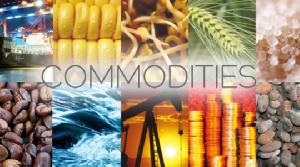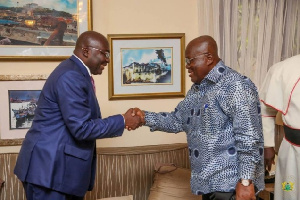Opinions of Wednesday, 24 January 2018
Columnist: Lloyd Evans
Ghana’s Commodity Exchange; How far are we?
In June 2015, the former President Mr John Mahama launched the Ghana Commodities Exchange (GCX) project with the aim of transforming the country’s agriculture.
The project was expected to become operational by 2016 with the establishment of the state-of-the-art, transparent and professional market institutions with the view of moving agriculture from subsistence to a market economy.
History
This is not the first time that the issue of an establishment of a commodity exchange had come up. Sometime in 1974 or earlier than that this issue came up with the creation of a physical exchange on the Ring Road Central about two blocks away from Paloma Hotel.
In 2009 the issue came up again for discussions with the hope that the exchange will see the light of day by the end of 2012. This never happened until June 2015 when the former President launched the project with all its fun fair.
The team working on this laudable project came out sometime in June 2016 and assured Ghanaians that the exchange will become operational in the first quarter of last year with maize, paddy rice an soya beans being listed on the exchange.
Like Oliver Twist we once again asked for more time. Joy Business News reported in August 2017, that the GCX is likely to be operational within the next 14 months.
What is a Commodity Exchange
A commodities exchange is an exchange where various commodities and derivatives products are traded on. Most commodity exchanges in the world trade in agricultural products and other raw materials like wheat, maize, sugar, cocoa, coffee, barley, oil and metals.
If Ghana has a commodity exchange, our gold, oil cocoa and coffee could be traded here instead of trading them in off-shore markets.
Trades on these exchanges are usually based on future contracts. A farmer planting maize or corn can sell a future contract on his produce which will not be harvested for several months. He will be guaranteed the price he will be paid when he delivers it. By this contract the farmer and the buyer are both protected by the fall and rise in prices.
Primarily, the objective of commodity exchange is to facilitate farmers and producers of agricultural produce with obtaining fair prices for their goods and merchandise and in accessing reasonable funding for their businesses.
In addition to this, the exchange is expected to create orderly, transparent and ready market for goods produced by farmers. It will also improve agricultural activities and improve the credit worthiness of farmers.
In Africa there are two major commodity exchanges. The South African Futures Exchange (SAFEX) established in 1990 and the Ethiopia Commodity Exchange (ECX), which was established in 2008. There are other smaller exchanges which are dealing with a single commodity or just two commodities.
African Markets
The Zimbabwe Agricultural Commodity Exchange which was set up in 1994 deals only in maize contracts. The Zambia Agricultural Commodity Exchange also founded in 1994 conducts spot and forward transactions in wheat, maize and other agricultural products, the Kenya Commodity Exchange launched in 1997 provides basic services in cereals and dairy products and cotton. There is also the Nairobi Coffee Exchange which intends to become the hub for the coffee trading in Eastern Africa.
The East African Community Exchange formed in 2014 in Kigali, Rwanda is privately funded regional exchange and deals in maize and beans with plans to expand into coffee, tea and rice.
Cote d’Ivoire has plans to set up an exchange for cocoa and Robusta coffee, while other exchange initiatives are taking place in Nigeria and Uganda. One could clearly see that all these countries know the benefit of commodity exchanges and have tirelessly worked to bring them into fruition.
Ghana Commodity Exchange
Ghana’s Commodity Exchange is being modelled on that of the Ethiopian Exchange which is based on the warehouse receipt system. This system will take off with warehouses in key farming communities to enable farmers easily access that platform and trade their commodities. It is also expected that 14 commodities will be traded in, beginning with four commodities – namely, maize both white and yellow, rice, beans and groundnuts.
This country remains largely an agricultural economy with 56 or per cent of the population employed as smallholder farmers. Out of this number over 60 per cent are women who on regular bases 45 per cent or more of their produce go waste as the result of post-harvest losses.
Agriculture in this country is rain fed and still using the old methods of hoes and cutlasses as production tools in this twenty-first century. It is therefore not surprising that agriculture is still being practiced by our aged parents. But the issue is how can we develop this very important sector to enhance growth and development.
On the Ethiopia Exchange for example by the end of 2011 the physical presence of the warehouses stood at 55 in 17 regional locations with trading growing from 140,000 tonnes to over 500,000 tonnes. The value of the exchange rose by 300 per cent in 2010 to US$1.1 billion in 2011. As at the end of November 2010, the trading floor in Addis handled 200 spot contracts in commodities such as coffee, beans, maize and wheat, with farmer cooperatives representing 2.4 million smallholder farmers.
Public Private Partnership
The GCX Project is supposed to be a Public Private –Partnership (PPP) initiative designed to transform Ghana’s agricultural sector. If that is really the case why is the government not taking the bull by the horn to push this agenda through and through? In the 2017 Budget Statement no mention was made to the GCX.
In the 2018 Budget Statement this is what the Minister of Finance had for the project “Work on the setting up the Ghana Commodity Exchange (GCX) and Warehouse Receipt System has been on-going for a decade.
The Exchange is expected to enable easy access to markets, fair pricing for smaller farmers and formalise informal agriculture trading activities. Government’s priority is to operationalise the Commodities Exchange in 2018 to support agriculture transformation including the Planting for Food and Jobs initiative”. Ref Para 836.
This statement no matter its intent and purposes cannot bring to fruition the establishment of a commodity exchange in this country. No budget allocation or line of expenditure. And for strange reasons this sector is under the Ministry of Trade and Industry instead of Ministry of Finance.
After the launch of the project in June 2015, the project team was expected to continue with a sustained sensitisation campaign around the country, involving the media, educational materials, TV, film and other materials to the various target groups. One is pretty sure that lack of funds for the project has stalled this important campaign.
May be we are underestimating the whole concept of the commodity exchange and the value chain for an effective and efficient exchange. Apart from the farmers, and the warehousing, there are other issues like transportation including cold storage vehicles, brokers, the use and application of ICT, agric extension offers to insure that farmers meet the grading and weight of the produce, accountants, banking services, sales and purchase of market data, creation and managing of websites among others.
What policy makers always tend to forget is that agriculture is demand driven and since we in this part of the world have made it supply driven we will continue to harvest post-harvest losses thereby making the sector unattractive and costly to our present and next generation.
Commodity markets never function in a vacuum. For the GCX to come on board and be active, the role of government is very important. The role of oversight, sanctity of contracts, providing the legal and regulatory framework, development of infrastructural frameworks are very critical. Markets need the government and the governments need the market.
Support of Government
Exchanges cannot do without the government, without framework, which can only be created by the government. Governments need to police the exchanges so that direct and indirect users can be assured that the exchanges serve the public rather than a particular private interest.
Taking into account the large potential benefit of commodity exchanges for a country’s economy, the government can also facilitate the growth of this emerging exchange by providing targeted support.
The Ghana Commodity Exchange (GCX) needs that targeted support to take off. So far as the economy is highly dependent on agriculture nothing stops the government to put in much effort for an effective and efficient exchange.
[email protected]











